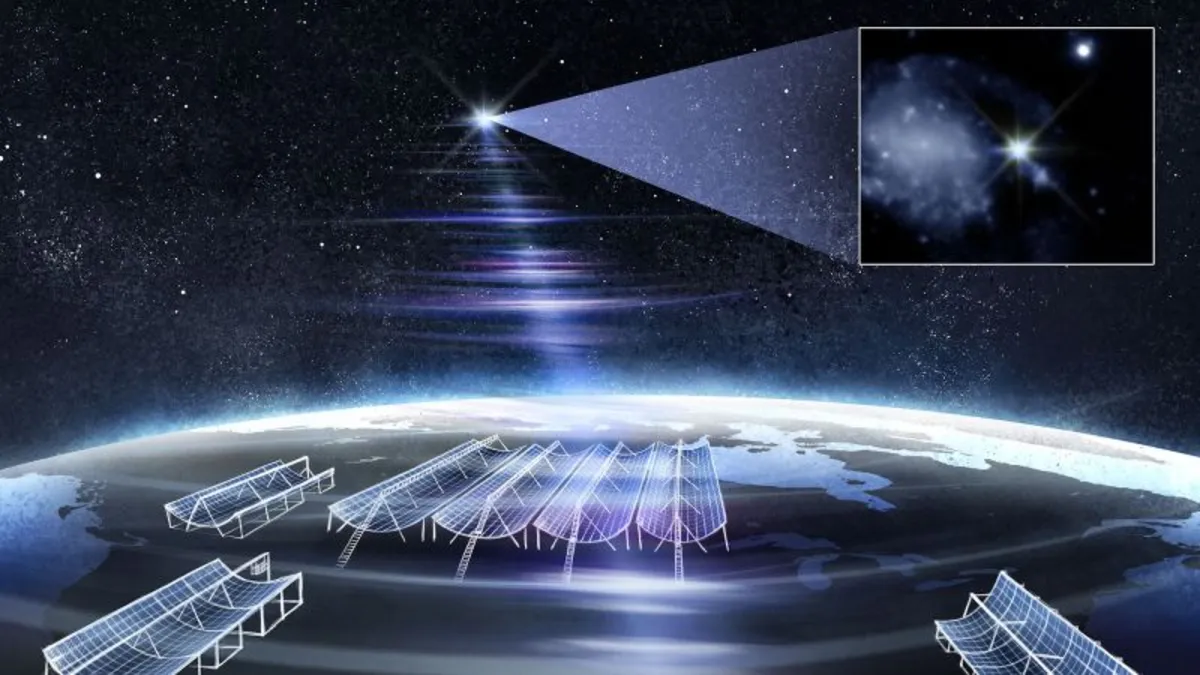
Astronomers have made a groundbreaking discovery by spotting the brightest fast radio burst (FRB) ever recorded, originating from a nearby galaxy. This remarkable event, characterized by a powerful flash of radio waves lasting only about a millisecond, could provide crucial insights into one of the most enigmatic cosmic phenomena studied to date.
Fast radio bursts, or FRBs, were first discovered in 2007, but the exact sources of these bursts remain largely unknown. Since their identification, astronomers have been diligently tracing the origins of these bursts in hopes of uncovering the mechanisms that unleash them and propel them across the cosmos. Recently, researchers observed FRB 20250316A, affectionately nicknamed “RBFLOAT,” which stands for “Radio Brightest FLash Of All Time.” This extraordinary signal was detected on March 16 and traced back to the galaxy NGC 4141, located approximately 130 million light-years away from Earth.
The details of this remarkable detection were made possible using the Canadian Hydrogen Intensity Mapping Experiment (CHIME) and its newly operational array of telescopes known as the Outriggers. The findings were published in The Astrophysical Journal Letters. Amanda Cook, the lead author of the study and a Banting postdoctoral fellow at the Trottier Space Institute and Physics Department at McGill University, emphasized the significance of the CHIME Outriggers: “With the CHIME Outriggers, we are finally catching these fleeting cosmic signals in the act — narrowing down their locations not only to individual galaxies, but even to specific stellar environments.”
Following the detection of RBFLOAT, scientists utilized the James Webb Space Telescope to closely examine the burst's origin. These observations lend support to a leading theory that suggests magnetars, the highly magnetized remnants of deceased stars, could be a source of fast radio bursts. Peter Blanchard, lead author of the Webb study and a research associate at the Harvard College Observatory, stated, “This was a unique opportunity to quickly turn JWST’s powerful infrared eye on the location of an FRB for the first time.” The analysis revealed a faint source of infrared light very near where the radio burst originated, potentially marking the first object linked to an FRB found in another galaxy.
The insights gained from both the CHIME and Webb studies could play a pivotal role in solving another mystery surrounding fast radio bursts: whether they exhibit a repetitive pattern, akin to a cosmic heartbeat, or if there are distinct categories of bursts that generate a singular, explosive signal before falling silent. Wen-fai Fong, a co-author on the CHIME study and an associate professor of physics and astronomy at Northwestern University, highlighted the significance of the CHIME radio telescope, which has enabled astronomers to detect thousands of fast radio bursts over the past seven years.
The CHIME Outriggers, recently operational at sites across British Columbia, West Virginia, and California, were designed to enhance the precision of tracing fast radio bursts back to their specific locations. According to Fong, the Outriggers combine pinpointing capabilities with an expansive field of view. The RBFLOAT burst released energy equivalent to what the sun emits over four days, but in less than a second. The Outrigger telescopes allowed the team to pinpoint the burst’s origin to a region about 45 light-years across, showcasing a precision comparable to identifying a quarter from approximately 100 kilometers (62 miles) away.
Follow-up observations conducted with the 6.5-meter MMT telescope in Arizona and the Keck II telescope’s Cosmic Web Imager in Hawaii revealed that RBFLOAT emerged from the spiral arm of a galaxy, an area rich with star-forming regions. However, the burst originated near, rather than within, a star-forming region. This raises intriguing possibilities about the nature of magnetars and their relationship with fast radio bursts. Yuxin (Vic) Dong, a graduate student and co-author of the study, noted that the burst's location outside a star-forming clump could imply that the magnetar was either displaced from its birth site or formed away from the clump’s center.
Blanchard’s team utilized the Webb telescope to search for infrared signals potentially linked to RBFLOAT. Their findings revealed an object named NIR-1, which could be a massive star or a red giant nearing the end of its life. While these stars are not direct candidates for causing fast radio bursts, the presence of an unseen companion, such as a neutron star siphoning material from the larger star, might be responsible for the radio wave emission. Blanchard remarked, “Whether or not the association with the star is real, we’ve learned a lot about the burst’s origin.”
Investigation into the environments surrounding both repeating and non-repeating fast radio bursts can help astronomers unravel the reasons behind the repetition of these signals. While many FRBs exhibit repeated pulsations over several months, RBFLOAT did not produce any repeat signals following its initial observation. As the first non-repeating burst to be localized with such precision, it poses critical questions about the nature of these cosmic phenomena. Sunil Simha, a co-author on the CHIME study, emphasized the significance of mapping out the local environment of RBFLOAT.
The ongoing studies of fast radio bursts, particularly through the efforts of the CHIME telescope and its Outriggers, hold promise for illuminating the mysteries surrounding these cosmic events. With plans to monitor the skies for additional non-repeating fast radio bursts, astronomers hope to uncover further insights into their origins. Cook expressed her excitement, stating, “We are really excited to uncover the mysteries the universe has in store for us.”